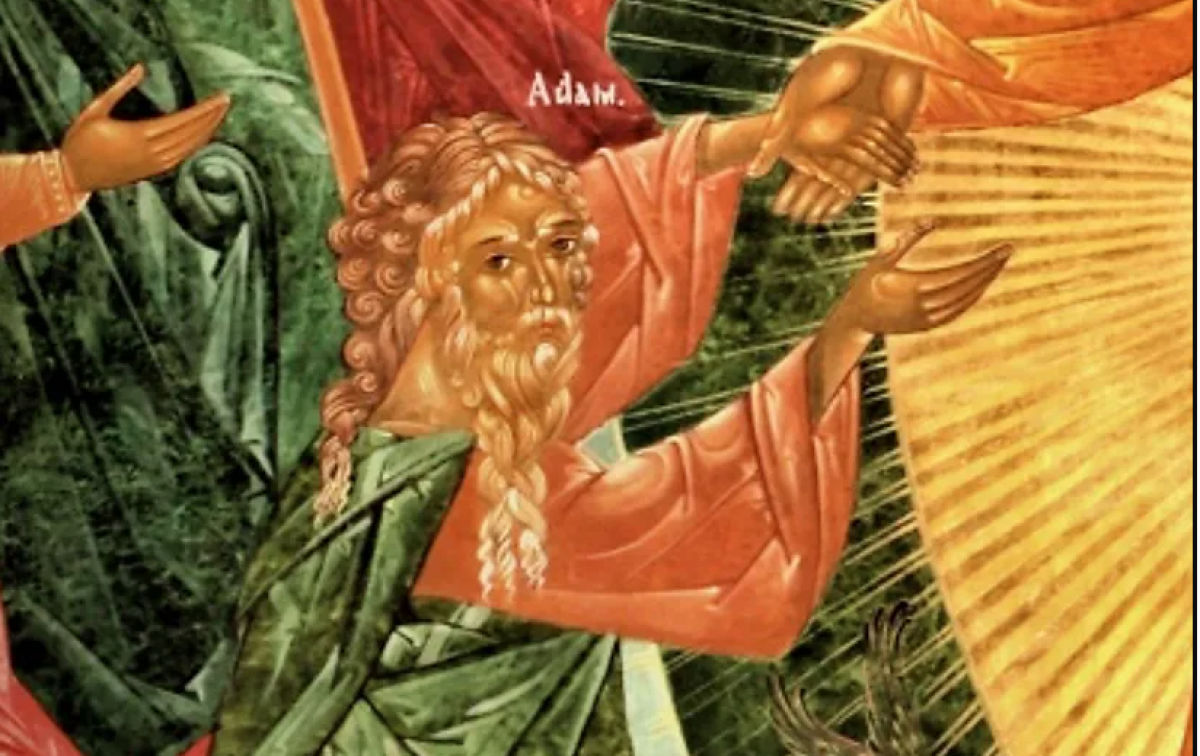April 27, 2022
Eternal Resurrection

In the little Anglo-Catholic Episcopal Church of the Transfiguration in New York City is a traditional painting of the Resurrection of Christ by master contemporary Russian American icon writer Vladislav Andrejev. It does not show the familiar scene of Jesus rising out of his tomb, dazzling the terrified guards, to which we are accustomed in the Western Church, but is envisioned by the iconographer in the Eastern Orthodox tradition as Christ’s decent into limbo, or Hades in Greek, the realm of the dead, where he rescues all those from the recent and the distant past who had died with the “hope of the resurrection.” It reveals the collective nature of resurrection, not only as a unique individual event in history but as a communal, corporate, and sublime occurrence taking place continuously in the realm of the Eternal.
The composition is arranged as a series of descending ovals that grow larger and larger as they descend. The topmost of these is almost circular and is centered where the horizontal crossbar meets the vertical post on the empty cross, situated high atop the mount of Golgotha, shown here in the Russian manner with the placard above and the plank to which his feet were nailed below. The second oval is delineated by the empty, negative space between stylized rock cliffs, the cross flanked by winged allegorical figures. One, clearly labeled “sophia,” represents wisdom. The other angelic being is “Agape,” one of the Greek words for love, indicating selfless fellowship. They point to the attributes of God most clearly revealed in Christ’s death and resurrection (1 Cor. 1:18ff., Rom. 5:8), and presumably double as the angels whom the three women will meet at the tomb in the morning.

Under the cross, a crevice in the mountainside reveals the skull of Adam deep in an underground cavern. From this tiny skull seems to open a new “window” in the composition, as if it were an enlargement of a detail under intensive magnification. This, the final and largest of the ovals, has three layers, one within the other like Russian matryoshka dolls. The first of these openings reveals a plethora of angels, traced delicately in dry brush, emerging from a light blue field, as if wispy clouds against a summer sky, each of them holding a candle. Within this opening is a darker orb, inhabited by six-winged seraphim illuminated in brilliant chiaroscuro by a third, innermost field of radiating gold that reflects light, creating a dazzling, luminous effect that changes and seems to shimmer as you move (something difficult to adequately capture in photos).
Within this oval within an oval within an oval, opening like petals of a rose, is Christ himself. His billowing garments flutter in the wind as if he has just alighted, almost weightless, his feet just barely touching the doors of Hades, yet knocking them down almost effortlessly. Trampled underfoot, the doors lay beneath him in an x configuration, suggesting cancellation. He has transformed the grim threshold of death into the gateway of eternal life.
To his right and left, Christ lifts up Adam and Eve from the grave. Eve seems still to be half asleep, but Adam, fully cognizant, looks directly at the viewer and with his right hand clearly indicates Christ as the source of his miraculous awakening from the long sleep of death. Behind Adam follows a succession of kings, prophets, saints, and martyrs, including David and solomon, John the Baptist, and others. Behind Eve, pious widows, holy virgins, and female saints follow her and take part in the general resurrection (the three Marys, to arrive at the tomb of Christ by dawn, are not yet among the dead).
All of the deceased are emerging from a cavernous, cloudy realm of darkness that seems to encompass everything below in the shadowy underworld of Hades and forms a gloomy backdrop to the dramatic scene unfolding against it. Above ground, by contrast, the background is of brilliant gold to suggest the eternal brightness of the kingdom of Heaven, whose impending dawn is just now breaking upon us this Easter morning; soon the three women will meet the angels stationed at the empty tomb in the world above.
Christ turns his head away from Adam and looks directly at the viewer with an intense, quizzical expression as if to ask us, “And you? Will you join us as well?” His intense gaze is not without an element of judgment, as if he is sizing us up, evaluating us, challenging us to rise to the promise of his salvation by living righteous lives guided by faith in the resurrection and strengthened by its power. This sublime icon acts as a solemn witness to the triumph of grace and mercy over evil and sin and of the ultimate victory of the kingdom of Heaven and God over the realm of Hades and death.
But the action depicted in traditional icons takes place not only in rational, linear time as it unfolds, but is also a process taking place outside of the strictures of time altogether, where Christ is eternally begotten, eternally dying, eternally resurrecting. Traditional Orthodox iconography represents this ungraspable, continuously occurring process in tangible form with natural materials, like egg yolk, pigment, and gold leaf on a wooden panel. These elements from the earth are transformed sacramentally by the artist to represent the unpresentable; an object that captures and fixes a fluid, eternal process as a singular event taking place in time. For this reason, 20th-century icon painter and theorist leonid Ouspensky aptly called Orthodox icons like this magnificent tour de force at Holy Transfiguration Church “Windows to Heaven,” offering to viewers on this side of death fleeting glimpses of the eternal Resurrection.
This article was originally posted through The Living Church and is reposted with permission from the author. Dr. Dennis Raverty is an associate professor of art history at New Jersey City University, specializing in art of the 19th and 20th centuries.
